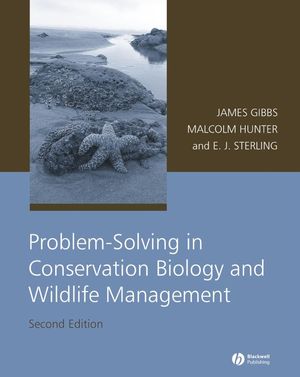Problem-Solving in Conservation Biology and Wildlife Management, 2nd EditionISBN: 978-1-4051-5287-7
Paperback
344 pages
February 2008, Wiley-Blackwell
 This is a Print-on-Demand title. It will be printed specifically to fill your order. Please allow an additional 10-15 days delivery time. The book is not returnable.
|
||||||
Copying.
Acknowledgments.
Part 1. Introduction.
1. What Is Biodiversity? Spiders As Exemplars Of The Biodiversity Concept.
2. What Is Conservation Biology? An Analysis Of The Critical Ecosystem Partnership Fund’s Strategies And Funding Priorities.
3. Why Is Biodiversity Important? Why Is It Threatened? An Exploration With The IUCN “Red List” Of Threatened Species.
Part 2. Genes.
4. Population Genetics: Diversity Within Versus Among Populations.
5. Genetic Drift: Establishing Population Management Targets To Limit Loss Of Genetic Diversity.
6. Pedigree Management: Controlling The Effects Of Inbreeding As Indicated By Fluctuating Asymmetry.
7. Landscape Genetics: Identifying Movement Corridors In The Landscape.
Part 3. Populations.
8. Life Table Analysis: Balancing Commercial Fisheries With Sea Bird “By-Catch”.
9. Population Viability Analysis: El Niño Frequency And Penguin Population Persistence.
10. Habitat Loss And Fragmentation: Ecological Traps, Connectivity And Issues Of Scale.
11. Diagnosing Declining Populations: Assessing Monitoring Data To Better Understand Causes Of A Rarity In An Endangered Cactus.
12. Estimating Population Size With Line Transects And DISTANCE.
13. Analyzing Camera Trap Data With PRESENCE.
14. Estimating Population Size With Mark-Recapture Data And MARK.
Part 4. Species.
15. Estimating "Biodiversity": Indices, Effort And Inference.
16. Designing A Zoo:Ex-Situ Centers For Conservation, Research, And Education.
17. Plant Reintroductions: Reestablishing Extirpated Populations.
18. Edge Effects: Designing A Nest Predation Experiment.
Part 5. Ecosystems And Landscapes.
19. Ecosystem Fragmentation: Patterns And Consequences For Biodiversity.
20. Forest Harvesting: Balancing Timber Production And Parrot Habitat.
21. Protected Areas: A Systematic Conservation Planning Approach For Ecoregions.
22. Island Biogeography: How Park Size And Condition Affect The Number Of Species Protected.
23. GIS For Conservation: Mapping And Analyzing Distributions Of Wild Potato Species For Reserve Design.
24. Global Change: Will A Cold-Adapted Frog Survive In A Warmer World?.
25. Climate Envelope Modeling: Inferring The Ranges Of Species.
Part 6. Policy And Organizations.
26. Population, Consumption, Or Governance: Which Drives Species Imperilment Most In Africa And Europe?.
28. Overconsumption: Who’s Smarter... Students Or Their Professors?.
28. Conservation Values: Assessing Public Attitudes.
29. Priority Setting: Where Around The Globe Should We Invest Our Conservation Efforts?.
30. An International Debate: Commercial Fishing In Galápagos National Park.
31. Conservation Law: Should The Polar Bear Be Listed As A Threatened Species?.
32. Conservation Policy: Shaping Your Government.
Index



